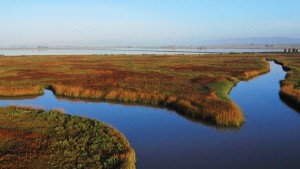Forty miles northwest of San Francisco, the San Andreas Fault slips into the Pacific Ocean, creating Tomales Bay, the outlet for countless creeks and rills in rainy West Marin. But for over 100 years, fresh water from Lagunitas Creek has not flowed freely through the estuarine transition zone. Levees, tide gates, and culverts built at the bay’s southern end near Point Reyes Station, coupled with increased sediment loads from logging and development, have deposited five feet of sediment and transformed the area from a dynamic wetland to a vegetation-choked meadow.
That is about to change. In June 2007, the state certified the $6 million Giacomini Wetland Restoration Project, encompassing both the 550-acre Waldo Giacomini Ranch, acquired in 2000 by the National Park Service, and the 63-acre Olema Ranch. In the site’s marshy floodplain, salinity fluctuates with the seasons, but the landscape has permanent freshwater edges, fed by fissures in the granitic Inverness Ridge on the Pacific Plate to the west, and a gravel layer in the mesas on the North American Plate to the east. Thus, at the marsh’s boundaries, riparian trees like arroyo willow and red alder grow alongside pickleweed and saltgrass.
During the two-year project—with work done between August and October to protect migrating fish and nesting birds—levees, tide gates, and berms will be removed, and Tomasini Creek will be realigned into one of its historical channels. The results should enhance habitat for many species, including the California clapper rail and the tidewater goby, both federally endangered. It should also improve water quality in Tomales Bay, which has been designated as impaired under the Clean Water Act. Project manager Lorraine Parsons says it will take five to ten years to see a complete change in the plant communities. Once more funding is secured, three public access trails will be added, including ADA-compliant access at White House Pool County Park, west of Point Reyes Station.
Restoration work began this fall and should be complete next year. The true restoration will begin once the tides and fresh water again flow naturally.

.jpg)



